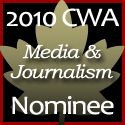This is part three of a series of postings I've compiled on Stephen Harper's involvement with the Pro-Apartheid movement of the 1980's; through both his Northern Foundation and the Reform Party of Canada.
With the Conservatives targeting Kingston for Brian Abrams, a column by the extreme right-wing journalist, Peter Worthington (father-in-law of a former insider and speech write of George W. Bush, David Frum), that appeared in the Kingston Whig Standard (part of the Sun Media chain), gave me the link I needed to tie everything together.
You will notice the name Craig Williamson in the video. From his Wikipedia bio: "Craig Michael Williamson (born 1949, Johannesburg), a former South African police major, was exposed as a spy in 1980, and was involved in a series of state-sponsored overseas bombings, burglaries, kidnappings, assassinations and propaganda during the apartheid era.
"Williamson was one of the main collaborators with Peter Worthington in the pro-apartheid video The ANC method - violence which was distributed by Citizens for foreign aid reform throughout Canada in 1988."
I discovered the links between the Northern Foundation, Peter Worthington, The National Citizens Coalition and the Reform Party of Canada, through an unlikely source. Ryerson's Review of Journalism. Who knew? In 1988 they published a review, and through that provided the rest of the story.
Ryerson's Review of Journalism
Spring 1988
by Dave Stonehouse
The red terrorist menace in South Africa - written by Peter Worthington, produced by Peter Worthington and starring Peter Worthington
A three-second aerial shot shows the tops of shacks in a rural slum. The as yet unseen narrator tells you it is Soweto, a black township in South Africa, "the scene of so many necklacings and violence."
Violins pitch and drone eerily behind his commentary. Now you're on the ground, about 10 metres from a shack where a large black woman is standing in the doorway. She's looking right at you, waving her left arm, pointing into the house, talking excitedly. But you can't hear her, only the narrator. He says she is Beverly, the 22-year-old daughter of Bartholomew Hlapane, former executive member of the African National Congress. He goes on to explain how she opened that door on December 6, 1982, to find herself face to face with a gunman.
The narrator stops mid-'sentence, for effect, and the woman's voice comes up: "He pointed at me with the gun and just started shooting ...not caring who he hit." The camera pans to show holes in the wall, then cuts to a still: a file shot of Beverly's father, Bartholomew, lying dead on the floor with shotgun wounds to his chest. His wife was killed in the attack, his other daughter paralyzed.
The narrator is Peter Worthington, former editor of The Toronto Sun, politician manque, freelancer and editor of Influence magazine. The dramatic reenactment of the Hlapane murder begins The ANC Method-Violence, a half-hour Worthington editorial on videotape that paints the African National Congress as a vicious, communist-controlled terrorist group. The brutally graphic production has been virtually ignored by the media.
South African expatriates and the ANC have labeled it propaganda; Worthington prefers to call it "a personal view." Hugh Winsor, national political editor for The Globe and Mail, who covered South Africa for the now defunct Toronto Telegram, says: "It is not straight-up journalism. I would have seen it as more valid if he indicated where he got the footage and where he got the help."
"Historically, it's a new kind of war, a new kind of morality," says narrator Worthington. "The war zone is the world, the aggressors are the PLO, the IRA, the ANC, the Red Brigade and a host of other revolutionary terrorist organizations." Sirens howl in the background. On the screen flash pictures of chaotic street battles and their repercussions: the dead and wounded lying on the ground; a limp, bloody body dropped into a coffin.
Worthington continues: "The front lines remain undeclared and the victims can be anybody." The violins sing their ghastly sear. Worthington guides the viewer through a series of "terrorist" acts. The aftermath of a bombing at the Rome airport. In South Africa, a woman lying on the ground, severely burned and swollen but still alive; she has been "necklaced," collared with an oil-soaked tire that was then set afire. The hijacking of a jet in the Middle East. Though the ANC is not explicitly linked to terrorist groups, Worthington's words and the file clips connect, in the viewer's mind, the South African political movement to terrorism.
Worthington appears, dressed in jacket and tie, staring out from the television screen. His voice is deep and smooth, with the hint of a lisp catching the occasional "s", his delivery flawless. "I'm afraid I'm convinced that the Western media, Western politicians and academics, and all too many church figures are not so much interested in a peaceful solution to South Africa's problems, but want bloodshed and an overthrow of the system-at any price-even if it ends up being a Marxist regime."
Then to a shot of Beyers Naude, a top official with the South African Council of Churches. He is speaking to a crowd, pledging "peace, but peace with justice," his head framed by the hammer and sickle on a banner behind him.
Craig Williamson, a burly white South African with a bushy brown beard and an English South African accent, appears in the video speaking out against the ANC. His knowledge of the topic is intimate: he is, according to the identification on the screen, a "former member of the ANC/ SACP [South African Communist Party]." Why he left is not revealed, but the impression is that he became disgruntled, as Bartholomew Hlapane had.
In fact, Williamson was a spy for South African government intelligence who infiltrated the ANC for two years, a fact not mentioned in Worthington's production. "He's an articulate man, and I thought that the information [Williamson had] was what was relevant, not the reasons why," Worthington says now. "It's the information that's important, not the source. [But] I wish, in retrospect, I had put that in.
"Worthington is adamant that the video was never intended to show both sides, just a different view. "I don't expect anybody to accept it as the oracle," he says, "but I think most of the stuff can be supported. There's no question that I'm not trying to do the ultimate pros and cons. When you start getting into that kind of thing, you get into a great, long documentary kind of thing, which I don't have either the knowledge or the resources to do adequately."
He says he made the video on the spur of the moment, out of frustration with Western media coverage of South Africa. While in the country last summer on a "six or seven" week assignment for Reader's Digest, he met up with four journalists who shared his view of Western news reporting.
According to Worthington, they agreed to pool their resources and produce the tape, using their employers' film, cameras and editing equipment (which is why he refuses to name his crew, except to say they are "private individuals" from England, Australia and South Africa).
"It's just a question of staying after hours," Worthington says. "It was done very quickly." He wrote the script one morning, then read it to camera that afternoon. And while he went about some interviews for his Reader's Digest piece (which in early March the magazine had neither received nor scheduled) a cameraman followed. The rest of the film was made up of file footage, some of it from the state-owned South African Broadcasting Corporation. Most of the editing was done in South Africa, with only the final cut, made in Canada.
Worthington had the finished product in his hands, having spent virtually nothing out of his pocket. "If it cost me anything, it cost me a cab ride," he says.
Distribution cost him even less. That was handled by Citizens for Foreign Aid Reform, a right-wing organization based in Toronto. CFAR agreed to the task after Worthington's attempts to get his taped views aired on public television got nowhere, says Paul Fromm, CFAR's research director. And while the television producers were saying no, CFAR's members were nodding yes, snatching up 4,000 copies of the tape and its 12-page companion booklet in five months.
Members of Parliament were each sent a copy, and 400 more went to major media outlets across the country.
Meanwhile, Worthington was also circulating copies to his friends, and this was how it caught the attention of David Somerville, a former employee of Worthington's at The Toronto Sun. Somerville is president of the National Citizens' Coalition, another right-wing pressure group in Toronto. He offered the tape to his membership, which numbers 36,000, at $12 apiece ("at cost"). The NCC sold 600-more than double what it expected.
Somerville calls the video a "journalistic effort at setting the record straight on the ANC."Others argue differently. The ANC's Canadian representative, Yusuf Saloojee, says, "What Worthington is doing is working the South African government propaganda machinery. It's a distortion of reality, of what is really going on in the country. He totally stays away from state violence."
"The video is not concerned with the truth," says Peter Harries-Jones, a former journalist in South Africa. "It doesn't want you to believe all of it. All it wants to do is put a quote in your mind: 'I, Peter Worthington, believe the ANC is a Marxist organization run by savages.'" Harries-Jones, now professor of anthropology at York University, believes the video could not have been made without some assistance from the South African government-a notion Worthington denies. Since censorship and other press restrictions were imposed under the state-of-emergency regulations, he says, scenes such as the ones in The ANC Method-Violence would be difficult to get. "
In order to go into the [black] townships as Worthington has done, he had to have permission-particularly to get the scenes of violence."Toronto Life editor Marq de Villiers, an Afrikaner and a former correspondent in South Africa, comments: "The video is a combination of truth, half-truth and misrepresentation." He feels Worthington truly believes the arguments in the video. "I don't believe he's a liar. He's sincere. But that doesn't mean he's telling the truth."
Throughout the books by Trevor Harrison and Murray Dobbin there are repeated references to Northern Foundation members also belonging to the National Citizens Coalition. Paul Fromm was a regular speaker at Northern Foundation conferences. The Reform Party was heavily involved in the Pro-Apartheid movement.
Their motivation was protecting corporations who would lose massive profit if they had to start paying the black labour force of South Africa, a reasonable wage. Reform members were extremely pro-Anglo, to say the least.
As Murray Dobbin points out, Stephen Harper was always careful not to write extremist views into their policy book, but I could see his involvement with these players feeding his ego.
But Peter Worthington now campaigning for the Conservatives? Yikes! I hope Brian Abrams knows what he's doing.



No comments:
Post a Comment